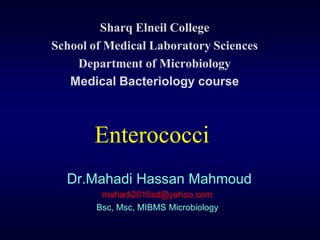
Enterococci ppt mahadi
- 1. Sharq Elneil College School of Medical Laboratory Sciences Department of Microbiology Medical Bacteriology course Enterococci Dr.Mahadi Hassan Mahmoud mahadi2010sd@yahoo.com Bsc, Msc, MIBMS Microbiology
- 2. The Natural habitat Normal components of the flora of: Intestinal tract Oral cavity Vaginal canal of humans and animals
- 3. Morphology Gram-positive cocci (0.5 and 1.25 micrometers in diameter) usually occur in pairs or short chains Non-capsulate Non-motile.
- 4. General properties: production of gas from glucose (most enterococci are negative) Have ability to grow at both 45°C and 10°C temperatures). Can grow on media containing Bile aesculin,
- 5. Medically Important species At least 12 different species have been associated with various illnesses Enterococcus faecalis and E. faecium — have emerged as a major cause of nosocomial infections
- 6. Culture &chaacteristics: Enterococci are aerobic organisms capable of growing over a wide temperature range, 10–45 ºC On blood agar, Enterococci are mainly nonhaemolytic but some strains show alpha or beta- haemolysis
- 7. ON MacConkey &CLED Ferments lactose, producing small dark- red magenta colonies on MacConkey aga small yellow colonies on CLED (cysteine lactose electrolyte-deficient) agar
- 8. Enterococcus species are also able to grow in the presence of 6.5% sodium chloride and 40% bile. When grown on media containing aesculin, enterococci hydrolyze the aesculin, producing black colonies.
- 10. Virulence Factor Polysaccharides on the surface of enterococci represent an effective way to prevent phagocytosis. Secreted factors (cytolysin/hemolysin, gelatinase and serine protease) cell surface-located proteins or adhesins (Esp) and the adhesin of collagen Adhesins (Acm and SagA)
- 11. Pathogeicity: Enterococcus faecalis, causing about 95% of enterococcal infections including infections of the Urinary tract infection Biliary tract,ulcers (e.g. bed sores) Wounds (particularly abdominal) Occasionally endocarditis or meningitis
- 12. Laboratory diagnosis specimens: Collection of Spacimen Direct Exam Culture Identificaion Serology Molecular characterization
- 13. Biochemical Tests Catalase negative Ferment lactose (also mannitol and other sugars). Hydrolyze aesculin Reduce litmus milk
- 14. grow on reduce sorbitol glycerol, D- L- melibios 0.4% tetrazol tagatose arabinos e telluride ium to e formaz an E. yes Yes Acid Acid Acid No Acid No Acid faecalis E. No No No Acid No Acid No Acid Acid Acid faecium
- 15. Lancefield Grouping Enterococci possess Lancefield Group D antigen (as also some streptococci). The Group D antigen of enterococci is unlike that of other Lancefield groups. It is not extracted by traditional acid extraction techniques. Enzyme techniquesbased on Maxted’s enzyme are required.
- 16. Antibiotic Resistant Most enterococci are susceptible to ampicillin and resistant to cephalosporins. Resistance is shown against penicillin. Vancomycinand ampicillin resistance appear to be emerging,associated particularly with hospital infections.
- 17. Penicillin or Ampicillin Vancomycin For urine isolates Fluoroquinolones Nitrofurantoin Fosfomycin Vancomycin-resistant strains (VRE)
- 18. THANK YOU FOR ATTENTION